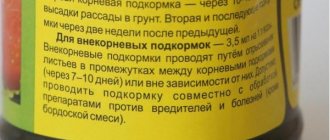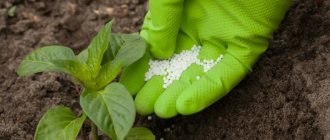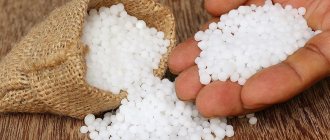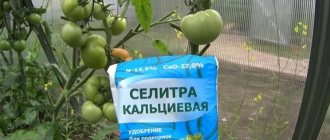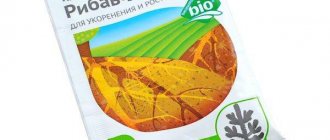Sometimes gardeners and vegetable gardeners, when pressed for time, need to fertilize various plants, but there are no specialized types of ZDRAVEN fertilizer at hand. In this case, “ZDRAVEN turbo universal” will come to your rescue, which also contains all the necessary substances. Of course, the effect of such feeding will be somewhat less, but it will still be very high. After all, it is known that a good decision at the right time is always better than great decisions at the wrong time.
- accelerates plant development;
- increases resistance to diseases;
- improves the taste and quality of products;
- enhances the color of flowers;
- increases overall and early harvest.
Packaging/barcode “Zdraven turbo UNIVERSAL - for vegetable, fruit and horticultural crops”:
| 4607043204486 | package 15 g |
| 4620015698083 | jar 300 g |
| 4607043200297 | package 30 g |
| 4607043200563 | package 150 g |
| 4607043201737 | box 150 g |
Composition: macroelements nitrogen 13%, phosphorus 10%, potassium 20%, magnesium 2%, sodium humate 2%; microelements boron 0.03%, manganese 0.04%, zinc 0.02%, copper 0.02%, molybdenum 0.005%, including in the form of chelates). Does not contain chlorine!
Application: for root feeding, dissolve 15 g of “Zdravnya” in 10 liters of warm water.
For seedlings: add another 3-4 g of urea to the solution. 1-2 days before feeding - water with clean water. Feed in the phase of 2–3 true leaves until the soil is completely moistened. 2nd feeding after 10–14 days.
After planting in the ground:
- 1st feeding: tomatoes, peppers, cucumbers, cabbage - 10–15 days after planting seedlings or emergence of seedlings; beets, carrots, root vegetables, annual flowers, onions and garlic - in the phase of 3–4 true leaves; potatoes - before the first hilling (before the rows close and budding); strawberries, raspberries, fruit trees, berry bushes, perennial flowers, ornamental crops, lawns - 15–20 days after the snow melts.
- 2nd feeding: 2–3 weeks after the first.
- 3rd feeding: during the period of crop formation, but not earlier than 2-3 weeks after the second.
After harvesting, feed: berry bushes, raspberries and strawberries. For all crops, foliar feeding by spraying is also recommended (10 g of fertilizer per 10 liters of water). Foliar feeding is carried out in the intervals between crown feedings or combined with spraying of plants against pests and diseases. In a heaped teaspoon 7–8 g, in a matchbox 18–19 g.
Safety precautions: use gloves when working. Afterwards wash your hands and face with soap. Store in closed, dry rooms, separate from products, in places inaccessible to children and animals. Non-hazardous cargo.
One of the most effective fertilizers for a rich tomato harvest is Zdraven. The drug has a complex effect on the plant, simultaneously protecting it from diseases, strengthening the bush and helping the tomatoes ripen.
How to use Zdraven for tomatoes
Description
This mineral supplement contains optimally selected important macro- and microelements that help accelerate plant development, increase the number of flowers and ovaries, increase the size and improve the taste of berries, leaf area, greater stress resistance and winter hardiness. Fruiting begins earlier and lasts longer.
Microelements (including in the form of chelates):
- boron (B) – 0.03%;
- manganese (Mn) – 0.04%;
- zinc (Zn) – 0.02%;
- copper (Cu) – 0.02%;
- molybdenum (Mo) – 0.005%.
The composition also contains sodium humate, but chlorine, which inhibits the root system of many cultivated plants, is absent!
The use of “Zdravnya” replaces several simple fertilizers at once, which need to be mixed, applied at a certain time, etc. As a result, the process of caring for strawberries and raspberries is simplified.
Composition and action
Zdraven does not offer any super miracles to plants, but provides them with timely, complete nutrition. Basic fertilizer Zdraven contains a typical set of basic (macro), meso- and microelements of plant nutrition:
- nitrogen (N) – 13% (macro).
- phosphorus (P) – 6% (macro).
- potassium (K) – 26% (macro).
- magnesium (Mg) – 2.5% (meso).
- manganese (Mn) – 0.04% (micro).
- boron (B) – 0.03% (micro).
- copper (Cu) – 0.02% (micro).
- zinc (Zn) – 0.02% (micro).
- molybdenum (Mo) – 0.005% (micro).
Note: the second meso-element sulfur S is not included in the Zdraven fertilizer, because Plants receive active sulfur in excess from atmospheric precipitation (technogenic) and with pesticides. Sulfur deficiency in private household plots is observed in exceptional cases, and overfeeding plants with it has a very bad effect on them.
Hello and carbamide
A reader knowledgeable in agricultural technology will note that there is a minimum of active nitrogen in the Zdraven fertilizer. This dosage is justified by the fact that in this way, with unqualified use, the accumulation of nitrates in fruits is eliminated. In addition, complex fertilizers with a high content of active nitrogen must be stored under special conditions, because explosive. And avoiding nitrogen chlorosis when using Zdraven fertilizer is very simple: you need to add 3-5 g of carbamide (urea) to each bucket of working solution. Urea contains amide nitrogen. In the soil, it takes a long time and slowly to be converted into active (assimilated by plants) nitrate. Plants to which Zdraven has given a nitrogen “primer” develop an appetite for nitrogen. Urea, gradually nitrifying in the soil, satisfies it as needed, without “stuffing” the plants with nitrates beyond measure. With this method of nitrate fertilizing, quite a lot of active nitrogen will be lost, but the price of urea is cheap.
Note: it is much more difficult to make urea detonate than nitrate fertilizers (for example, saltpeter), but still you should not purchase more urea than you need for the season. Urea should be stored in a tightly closed container/dishes in a dark, dry, cool place. It is unacceptable to use open fire and/or electric heating devices in nitrogen fertilizer storage, as well as devices that produce electric sparks or arcs (welding) and photo flash.
How does Zdraven work?
The effect of the Zdraven fertilizer on plants is as follows. way:
- The basic NPK complex is necessary for normal plant development. Nitrogen is used to build plant tissue. Phosphorus regulates the entire hormonal system of plants, ensuring their proper development and defense mechanisms against diseases and pests. Potassium, firstly, “switches” the phases of plant development: from germination to the growth of green mass; when there is enough of it and external conditions are acceptable, it “turns on” flowering and fruiting (the correct balance of potassium produces many large, juicy, sugary and/or starchy fruits); then, with a seasonal deterioration in external conditions, it “gives a signal” about the need to prepare for winter (for perennials) or “it’s healed, it’s time!” in annuals. Secondly, during the growing season, potassium increases the resistance of plants to unfavorable external conditions; First of all, to drought.
- Magnesium is the active nucleus of the chlorophyll molecule.
- Manganese, together with potassium, ensures the accumulation of ascorbic acid and sugars in fruits.
- Boron - reduces the amount of barren flowers and the fall of ovaries. Together with potassium, it regulates the accumulation of sugars and starch in fruits.
- Copper – primarily ensures turgor (good tension) and proper functioning of cell membranes. With a copper deficiency, plants wither, do not respond to watering, poorly absorb nutrients, and grow ugly.
- Zinc – necessary for the synthesis of growth substances. An optimal balance of zinc in the plant produces large, regularly shaped fruits.
- Molybdenum is also part of the phytohormones of growth. Denitrifies residual nitrates in green mass and fruits and removes their breakdown products (primarily free nitrogen). Promotes the synthesis of amino acids and plant proteins.
Turbo additives
“Simple” Zdraven is, in general, an ordinary complex fertilizer no better than cheaper and home-made analogues. Zdraven Turbo fertilizers, highly specialized for various crops, are deservedly popular. In addition to those mentioned above, their composition includes trace elements iron and cobalt, as well as sodium humate:
- Iron is an activator of chlorophyll synthesis and its essential link. In the process of chlorophyll formation, its precursor is first synthesized, vaguely similar to blood hemoglobin - its active nucleus is an atom of divalent iron. The iron is then replaced by magnesium.
- Cobalt – enhances plant survival systems in initially thin soils, e.g. soddy-podzolic. The soil in private household plots and dachas is similar in properties to sod-podzolic soil; sowing nitrogen fixers and green manures over it is of little use. In such conditions, cobalt makes it possible to cultivate the soil with relatively weakly nitrogen-fixing legumes such as peas. In addition, crops with a weak superficial root system (cucumbers) and tubers that require nutrient-rich soil (potatoes) grow and bear fruit better.
- Sodium humate – structures the soil without oversaturating it with potassium. Particularly useful for cucumbers and other plants with a shallow root system.
Note: cucumbers that receive the optimal amount of cobalt almost never taste bitter.
Hello and chelates
What are chelates and why chelated fertilizers are much more effective than conventional fertilizers, enough has already been written about this. Let us briefly recall: chelate compounds retain nutrient ions in an active form that can be absorbed by plants, for example. iron in the form of Fe(II), rather than the stable but useless Fe(III) for plants. Outside the chelate shell, the active ions in the soil are quickly neutralized and wasted. In addition, the chelates themselves gradually disintegrate under natural conditions, releasing active ions. If the rate of decay of the chelating agent (chelating or chelating agent) coincides with the dynamics of the plant’s need for this element, it receives it in just the right amount for quite a long time. During the growing season, plants, depending on the current phase of development, require different microelements or the same one, but in different quantities, see for example. rice.:
The gross (percentage) chemical composition of Zdraven fertilizers of different types is not fundamentally different. But the agents chelating their active substances are selected according to the dynamics of the target crop’s need for a given element. This leads to an important conclusion: use Zdraven fertilizers only for their intended purpose. If you feed Zdraven for onions and garlic, for example, cucumbers, there will be no harm - Zdraven fertilizers are safe for plants. But the effectiveness of fertilizing will be very low or even zero.
Features of preparative forms
The Zdraven fertilizer is produced in the forms of water-soluble VRP powder and a concentrated solution of KR (Zdraven Aqua preparation). Zdraven GRP is cheaper, but the entire contents of the package must be used immediately - the drug is not stored in an opened bag. Zdraven Aqua can be taken from the opened container in parts (see also below). Working solutions are not stored in any case and must be used within 6 hours. The choice of one or another preparative form is also determined by certain accompanying circumstances.
First, Zdraven fertilizers are available in packaging down to the smallest size, on the left in Fig. Zdravena for fruits and vegetables goes on sale packaged from 10 g, this is enough to apply to 1-1.5 square meters. m of planting. Onions, garlic, and green crops as an aid to the table can occupy an area of the same order of magnitude in private household plots; packaging should be selected accordingly.
Universal fertilizer Zdraven MIX Turbo
Second, Zdraven is also available in the form of MIX Turbo (GRP), see fig. on right; synonym Zdraven Turbo Universal. This preparation is suitable for systematic feeding of all major open ground crops, if they are sufficiently well-groomed and do not show signs of starvation for one or another nutrient. In greenhouse farming, Zdraven MIX Turbo is not very effective, and for neglected plantings and/or starving or diseased plants it is not effective at all.
Third, the features of liquid forms are more important. Their gross chemistry and chelating agents are different because... The purpose of the drug is also different. If Zdraven Aqua for fruits and vegetables (in the center in the figure) is, in general, an ordinary liquid complex fertilizer, then Zdraven Aqua for wintering orchids (on the right) is more likely a means of maintenance therapy in a difficult and dangerous development phase for plants. Its chemical composition and chelating agents are significantly different from those of other fertilizers of the same series, and “winter” Zdraven is not interchangeable with them; it is an extremely specialized drug. How to use Zdraven on wintering orchids, see also video:
Video: about Zdravne Aqua for orchids
Instructions for use
“Zdraven turbo for strawberries and raspberries” is used for both root and foliar feeding. The fertilizer dissolves easily in water, especially warm water.
Root feeding is carried out:
- before the start of flowering in the spring (2-3 times a month) – 15 g “Zdravnya” + 5 g urea + 10 l of water;
- during the fruiting period (2-3 times a month) – 15 g “Zdravnya” + 10 l of water;
- at the end of the harvest - 15 g of “Zdravnya” + 5 g of potassium sulfate + 10 l of water.
Foliar feeding is carried out by spraying a nutrient solution (in lower concentrations) over the leaves. For 10 liters of water take 10 g of “Zdravnya”. It is recommended to perform the procedure once every 2 weeks. At the same time, plants can be treated with other drugs aimed at combating pests and diseases.
If you don't have measuring scales at hand, you can use the following criteria:
- 1 tsp. with a slide – 7-8 g;
- 1 tbsp. l. with a slide – 20-22 g;
- matchbox – 18-19 g.
Detailed description
Fertilizer Zdraven for berry fields and berry crops.
ZDRAVEN-AQUA for berry fields and berry crops is a liquid complex organomineral fertilizer for root and foliar feeding of berry fields and berry crops (strawberries, currants, raspberries, etc.) on private farms. Accelerates the development of plants and the timing of crop ripening. increases the number of ovaries and berries, as well as the area of leaves. The berries become larger and more sugary. Increases winter hardiness and disease resistance. significantly increases productivity. Convenient to use, easily and accurately dosed, economical. Contains an optimal set of macro and microelements for feeding berry fields and berry crops. Does not contain chlorine.
Dimensions and weight (gross)
Video
Proper feeding of plants is an issue that concerns many gardeners and gardeners. Among the wide variety of products on the modern agricultural market, it is difficult to choose the optimal drug for a particular case. “Zdraven” is deservedly popular , well-digestible type of fertilizer, the components of which are the microelements necessary for plants for stable vegetation. This product, which is optimal due to its rich composition, is suitable as a top dressing for any crops.
Types of Zdraven fertilizer
There are many types of fertilizers that will satisfy the needs of any type of seedling. Small differences lie in the form produced and in the composition, which is selected depending on the plant.
Series “Zdraven – Aqua”
It is characterized by a liquid form of release, which is as convenient as possible for best absorption by the root system. Fertilizer "Zdraven - Aqua" represents a wide variety of types intended for enriching soils under vegetable crops:
- carrot,
- cucumbers,
- tomatoes,
- cabbage,
- potatoes, etc.
- garden flowers and fruit trees (apple trees, pears, etc.).
Series “Zdraven – Turbo”
The difference from the previous one is the solid, easily soluble in water form in which “Zdraven” is presented. Such products are convenient for transportation over long distances; they can be used when feeding various crops.
Advantages
“Zdraven” is an effective fertilizer that helps improve soil properties, increase the quality and quantity of crops, and protects plants from various harmful organisms and nutrient deficiencies.
Also, the positive characteristics of “Zdravnya” include:
- complete composition, characterized by an abundance of necessary elements;
- minerals are added in the form of chelates;
- no chlorine;
- low fertilizer costs for optimal plant nutrition;
- species diversity;
- different forms of release;
- good water solubility and absorption into the soil;
- will not cause difficulties in use and storage.
“Zdraven” can be used as a prophylactic agent, and not just as a plant fertilizer.
Composition and properties
The content of macro- and microelements and their concentration is regulated depending on how the fertilizer will be used. The main components are:
| Element | Function |
| Nitrogen | Participation in photosynthetic and protein-forming processes |
| Potassium and copper | Regulation of growth, metabolism and water-salt balance |
| Molybdenum | Promotes the absorption of nitrogen, affects the quantitative indicators of the yield |
| Phosphorus | Responsible for the processes of flowering and budding, important throughout the entire period of plant life |
| Manganese | Stabilization of the respiratory process and glucose levels |
| Bor | Forming immunity to various diseases, maintaining a healthy appearance |
| Zinc | Affects the quality of fruits, participates in the processes of metabolism and synthesis of vitamins and other substances |
Composition of Zdraven fertilizer
At different stages of growth, plants require a certain set of elements. The lack of one or another growth component immediately affects the plant and fruit ripening.
All these necessary elements are contained in the Zdraven fertilizer.
| Microelements | Lack of element | What does the plant need? |
| Nitrogen | The leaf turns yellow, becomes smaller, growth slows down | Provides photosynthesis and the formation of new plant tissues |
| Phosphorus | Buds and flowers fall off, fruits and vegetables taste sour | Stimulates growth and flowering, absorption of fertilizers |
| Potassium | Impaired water balance, pale color of vegetables | Maintains water balance in plant cells, affects the rate of ripening |
| Manganese | Stunted growth, leaf flies | Forms the level of sugars, controls the respiration of plant cells |
| Iron | The leaves turn yellow, the shoots dry out, the inflorescences become small | Promotes the formation of chlorophyll |
| Bor | The buds and leaves dry out and fall off, the fruits become smaller. stems are cracking | Reduces the risk of barren flowers, stimulates root growth, increases the content of starch and sugars |
| Copper | Growth inhibition, seeds form poorly, inflorescences become smaller | Regulates water balance |
| Zinc | Nitrogen metabolism is disrupted, growth slows down, leaves curl | Affects the size and taste of fruits and vegetables |
| Molybdenum | Curling and wilting of leaves, shredding of flowers and inflorescences | Destroys nitrates in fruits and vegetables, increases the volume of yield and vitamin C |
| Cobalt | Nitrogen metabolism is disrupted, growth slows down, leaves curl | Regulates water balance, increases productivity |
Approximate prices for fertilizer
“Zdraven” is sold in small packs in gardening stores. The cost of a standard package for one supplement is about 5 rubles, the price of a container with 150 g of the drug does not exceed 40 rubles.
A budget-friendly and effective product suitable for fertilizing vegetable and garden crops throughout the entire life process. The abundance of macro- and microelements simplifies work on the site and increases productivity, immunity, and improves the external characteristics of vegetation.
Fertilizers for plants, including strawberries, or rather garden strawberries, can be added to the main dressing, during planting and during fertilizing.
Features of application and consumption rates
Instructions for using the Zdraven fertilizer are always attached to the product and contain a detailed description of fertilizing, as well as specific points for its application. The selected type of product is applied to the soil at the root of the plant in liquid form after preliminary dilution with water.
Before using fertilizer, seedlings must be well watered.
The average amount of the substance is about 15 g per 10 liters of water, this is enough for complete nutrition. Feeding frequency is once every 2 weeks (this scheme is used for all types of “Zdravnya”, unless otherwise indicated in the description of a specific variation).
"Universal"
Suitable for any garden and vegetable crops, as well as indoor plants. The best time for initial watering with fertilizer is individual for each planting. The frequency of applying “Zdravnya” is once every couple of weeks. The total number of feedings is 3.
"MIX Turbo"
The Zdraven Turbo fertilizer is similar in composition, properties and method of application to the universal type. Vegetables and fruit trees are fertilized with a solution prepared according to the general scheme.
For seedlings
Fertilizer "Zdraven" for seedlings is the most optimal version of the drug for young plants. Its use will form seedlings’ resistance to adverse weather conditions, pests and diseases. The necessary complex of microelements and nutrients forms the basis for the full formation of an adult plant.
For strawberries
Fertilizing has a beneficial effect on the growth and development of bushes, regulating the amount of water and sugar in the berries. Constant use of fertilizer promotes stable flowering and fruiting of strawberries. For watering and spraying, a standard solution is used, which is used to water the bushes at the root in the spring before the budding process begins.
We fertilize remontant varieties
The peculiarity of feeding remontant varieties is that the formation of flower buds in strawberries occurs over a longer period of time. Plants of these varieties of strawberries and wild strawberries require intensive nutrition. This especially applies to varieties independent of daylight hours. They are designated NSD.
Many phosphorus-containing fertilizers, such as superphosphate and AVA fertilizer, dissolve slowly, so if you applied superphosphate before planting or AVA fertilizer during planting, then when fertilizing strawberries you need to add more nitrogen and potassium, as well as magnesium and microelements. These elements can be added to strawberries as part of fertilizers such as infusion of manure or chicken droppings.
The difference is in the degree of dilution: the infusion of cow manure is usually recommended to be diluted 5 times, and horse and bird droppings 10 times. Some gardeners suggest feeding remontant strawberries 10 or even 15 times per season. In the author's opinion, for some varieties of strawberries this is overkill, since a significant part of the nutrition must be added before planting and during planting. That is, for strawberry varieties that bear fruit twice a season, 2-4 feedings during the growing season may be sufficient.
Fertilizing large-fruited strawberries
But for large-fruited varieties with independent daylight hours, more frequent feeding may be needed - up to 10-12 times per season, depending on the length of the growing season. The first feeding of strawberries is recommended approximately (depending on the climate and weather conditions in your area) at the end of May with a 0.3% urea solution. The authors of some articles, unfortunately, frivolously suggest applying a 1-2% solution, although in such a concentration the fertilizer can be harmful. Further fertilizing is usually recommended with organic fertilizers. In the absence of manure or chicken droppings, in the author’s opinion, herbal infusions can be used. For example, nettle, dandelion, extracts from vermicompost or complex mineral fertilizers such as Zdraven, Fertika. The frequency of fertilizing strawberries should depend on the characteristics of the variety, the amount and type of fertilizers applied before planting and in the holes, the type of soil on the site, as well as on the physiological state of the plants themselves. The last two circumstances must be taken into account when preparing fertilizer liquid.
Quality and reliability
The instant preparation "Turbo" is diluted simply with water at room temperature. Dissolves completely and does not form sediment. At the same time, the solution is easily and quickly absorbed by the roots due to the special chelated form of minerals.
Thanks to the sodium humate contained in the fertilizer, fertilizing helps improve the soil structure and minimizes harmful substances contained in the soil. Regular use of the drug helps strengthen the root system of plants, as well as increase their immunity and resistance to diseases and difficult weather conditions.
For convenience, a whole group of “Turbo” preparations is on sale, which includes 18 highly specialized products depending on the variety of plants.
The fertilizer has the greatest positive effect on garden crops in open ground; in greenhouse conditions, Zdraven Turbo is ineffective.
To prepare the solution, use 20...40 g of dry product per 10 liters of water, the components are thoroughly mixed until completely dissolved. A composition of higher concentration is used for irrigation by the root method (it is convenient to connect a drip system); a weaker dilution is suitable for spraying on the leaf. This volume is spent per hundred square meters of land.
Features of the use of fertilizers
Use of saltpeter
Nitrate is the name given to fertilizers containing certain nitrates, for example potassium nitrate - potassium nitrate, calcium nitrate - calcium nitrate, ammonium nitrate - ammonium nitrate. From the point of view of plant physiology, it is possible to feed strawberries with saltpeter. However, to prevent the accumulation of nitrates in berries, saltpeter should be added in advance - at the beginning of leaf growth and during budding, so that the plants have time to process nitrates into vitamins, amino acids and other organic substances. Adding saltpeter to strawberries at later stages will cause nitrate contamination of the berries. Of the types of nitrate sold for strawberries, ammonium nitrate is most often used, less often potassium nitrate. The use of calcium nitrate for strawberries is acceptable, but it is better to use it for other crops.
How to feed strawberries
Based on the method of using fertilizers, fertilizing is divided into root and foliar. The first type involves applying fertilizer to the ground, and the second - spraying on the leaves. The effect of root feeding appears within 2-3 or more days and can last from 10-14 days to a month, depending on the type of soil and the fertilizer itself. The effect of foliar feeding usually appears within 1-2 days.
In the form of foliar feeding, it is better to use mineral microfertilizers and fertilizers containing amino acids, some growth and other physiologically active substances. For example, it is believed that microelements, as well as some macroelements from fertilizers, are more fully absorbed when applied on the leaves, that is, by spraying.
In addition, it is advisable to apply fertilizers in the form of foliar feeding in case of acute starvation of plants for individual elements, including nitrogen, phosphorus, boron, magnesium, and in cases where it is necessary to obtain a quick effect.
scientist agronomist Alexander Zharavin
Quickly by variety
- For seedlings, use a solution of low concentration (10 g/ml per bucket of water), water the young shoots on damp soil.
- For strawberries, potassium sulfide (5...10 g) is added to the working composition of 15...20 g of “Zdraven” and 10 liters of water; the procedure is repeated every 7...12 days.
- Cucumbers are fed with a standard solution up to 5…6 times per season.
- Tomatoes are fertilized at intervals every two weeks with a solution of normal concentration (up to 40 g).
- The drug is applied to potatoes three times: at the time of the first hilling, then twice with breaks of 14 days.
- Cabbage is also fed three times a season: two weeks after planting, then at the same interval.
- Fertilizer is applied to onions and garlic three times: immediately after germination, when the shoots have grown by 8...12 cm, and during the turnip formation phase.
- Fruit trees are fed 3...4 times (depending on the type, age and size): during the budding stage, after flowering, during the formation of the ovaries and during their ripening.
The drugs are very popular due to their clear advantages over analogues: easy to use, product consumption is minimal, the benefits are enormous, and the impact is high. At the same time, fertilizer is sold everywhere and at an affordable price, and you can always choose a unique product developed specifically for a specific crop.



